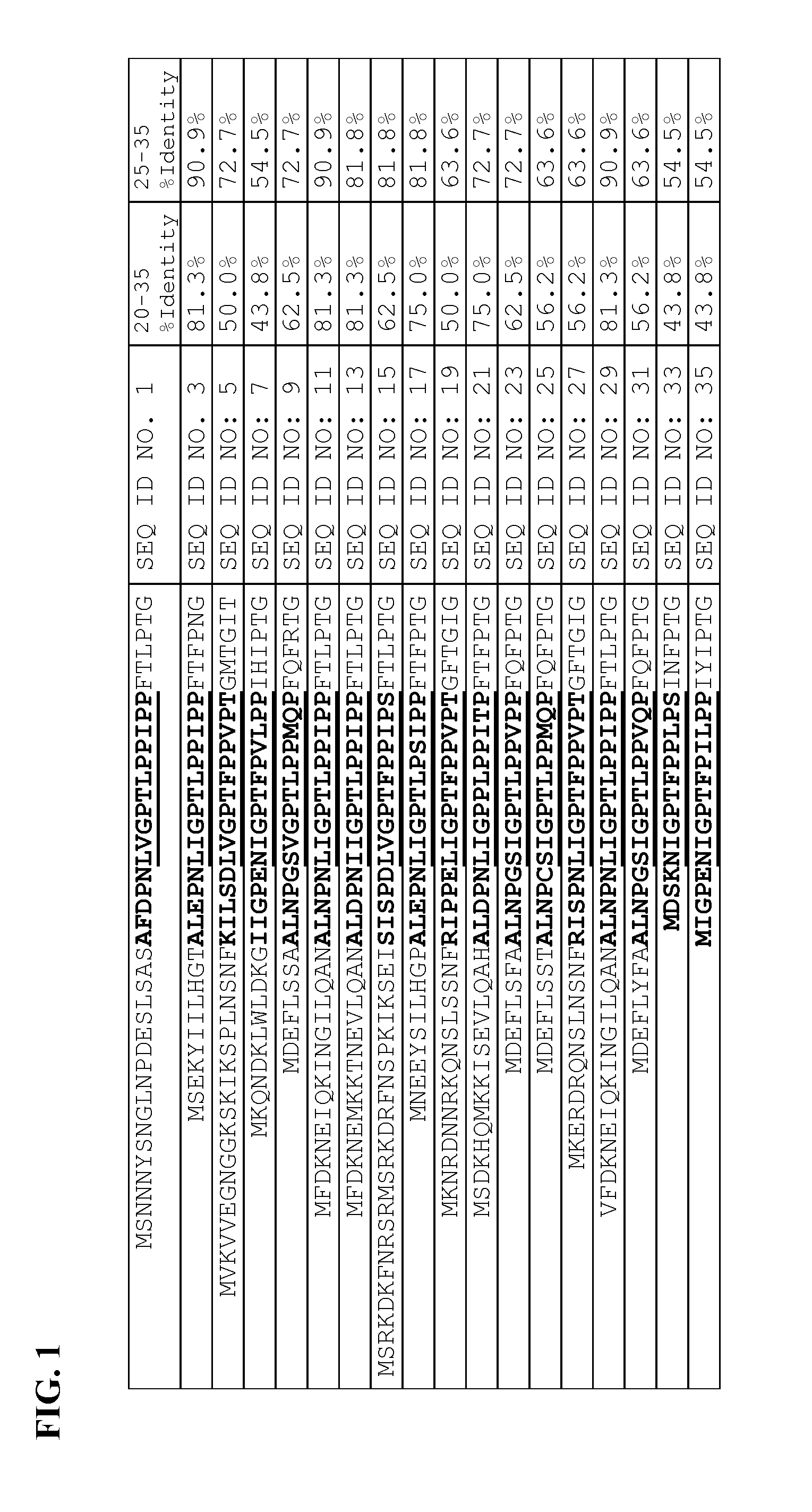Fusion proteins and methods for stimulating plant growth, protecting plants from pathogens, and immobilizing bacillus spores on plant roots
a technology of fusion proteins and plant roots, applied in the field offusion proteins, can solve the problems of low peptides, etc., and achieve the effects of reducing the number of bacterial pathogen reducing the survival rate of enzymes, proteins, and peptides in the soil, and reducing the survival rate of bacterial pathogens
- Summary
- Abstract
- Description
- Claims
- Application Information
AI Technical Summary
Benefits of technology
Problems solved by technology
Method used
Image
Examples
example 1
Use of a Recombinant Bacillus cereus Family Member Displaying a Lipase or an Endogluconase to Stimulate Plant Growth in Soybeans
[0225]The Bacillus subtilis lipase and endoglucanase genes were amplified via polymerase chain reaction (PCR) using the following primers shown below in Table 2:
TABLE 2lipaseendogluconasefor-ggatccatggctgaacacaatccggatccatgaaacggtcaatcward(SEQ ID NO: 37)(SEQ ID NO: 39)re-ggatccttaattcgtattctggcggatccttactaatttggttcversectgt(SEQ ID NO: 38)(SEQ ID NO: 40)
[0226]To create fusion constructs, genes were fused to the native bclA promoter of Bacillus thuringiensis DNA encoding the first 35 amino acids of BclA (amino acids 1-35 of SEQ ID NO:1) using the splicing by overlapping extension (SOE) technique. Correct amplicons were cloned into the E. coli / Bacillus shuttle vector pHP13, and correct clones screened by DNA sequencing. Correct clones were electroporated into Bacillus thuringiensis (Cry-, plasmid-) and screened for chloramphenicol resistance. Correct transform...
example 2
Use of a Recombinant Bacillus cereus Family Member Displaying an Endoglucanase to Stimulate Plant Growth in Corn
[0229]BEMD spores expressing endoglucanase were created in an identical fashion as described above in Example 1. Field corn was planted 1.5 inches (3.8 cm) deep in 10 cm deep pots filled with standard loam topsoil. Spores, control and BEMD expressing endoglucanase, were diluted to a concentration of 1×104 / ml in 50 ml of water and applied to each plant at planting. A water-only control was also included. Plants were grown under ideal light using T5 lamps, 54 watts, and exposed to 11 hours of light a day under controlled temperature conditions between 60-78° F. (15.5-25.5° C.). Plants were watered to saturation every three days over the one week trial. At the end of one week, the height of each plant was measured, and measurements were normalized to control Bacillus thuringiensis spores.
[0230]Results are shown in Table 4, together with the standard error of the mean. Corn gr...
example 3
Use of a Recombinant Bacillus cereus Family Member Displaying an Endogluconase or a Protease to Stimulate Plant Growth in Wheat
[0231]BEMD spores expressing endoglucanase were created in an identical fashion as described above in Example 1. BEMD spores expressing E. coli protease PtrB were created using similar methods to those described above in Example 1 and the following primers: ggatccatgctaccaaaagcc (forward, SEQ ID NO: 41) and ggatccttagtccgcaggcgtagc (reverse, SEQ ID NO: 42).
[0232]Winter hard wheat was planted 1 inch (2.54 cm) deep in 10 cm deep pots filled with standard loam topsoil. Spores, control and BEMD expressing endoglucanase or protease, were diluted to a concentration of 1×104 / ml in 50 ml of water and applied to each plant at planting. A water-only control was also included. Plants were grown under ideal light using T5 lamps, 54 watts, and exposed to 11 hours of light a day under controlled temperature conditions between 60-78° F. (15.5-25.5° C.). Plants were watered...
PUM
| Property | Measurement | Unit |
|---|---|---|
| temperature | aaaaa | aaaaa |
| temperature | aaaaa | aaaaa |
| av | aaaaa | aaaaa |
Abstract
Description
Claims
Application Information
 Login to View More
Login to View More - R&D
- Intellectual Property
- Life Sciences
- Materials
- Tech Scout
- Unparalleled Data Quality
- Higher Quality Content
- 60% Fewer Hallucinations
Browse by: Latest US Patents, China's latest patents, Technical Efficacy Thesaurus, Application Domain, Technology Topic, Popular Technical Reports.
© 2025 PatSnap. All rights reserved.Legal|Privacy policy|Modern Slavery Act Transparency Statement|Sitemap|About US| Contact US: help@patsnap.com

